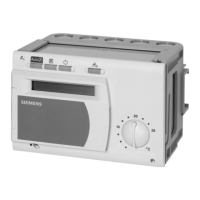83/130
Siemens Building Technologies Basic Documentation RVD230 CE1P2383en
HVAC Products 22 Locking signals 27.05.2004
22 Locking signals
22.1 Fundamentals
The following functions use locking signals for the heat converters and consumers:
• Minimum limitation of the boiler return temperature
• Protective boiler startup
• D.h.w. priority
With the heat converter and load controllers, it is possible to set on operating line 136
(gain of locking signal) to what degree they shall respond to a locking signal. This gain
of the locking signal is adjustable from 0 % to 200 %.
For heat converters and consumers with 3-position control, following applies:
Setting operating line 136 Response
0 % Locking signals will be ignored
100 % Locking signals will be adopted 1-to-1
200 % Locking signals will be adopted as double signals
For consumers with 2-position control, following applies:
Setting operating line 136 Response
0 % Locking signals will be ignored
>0 % Locking signals will be adopted 1-to-1
There are 2 types of locking signals:
• Uncritical locking signals
• Critical locking signals
The response of the consumers / heat converters depends on the type of locking sig-
nal.
22.2 Critical locking signals
Critical locking signals are generated by the boiler controller with protective boiler star-
tup or during minimum limitation of the boiler return temperature, aimed at throttling the
consumers to get out of the crucial range more quickly.
If the boiler is in segment 0, the critical locking signal will be sent to all heat converters
and consumers in the entire bus system.
If the boiler controller is in segment 1
…14, it will only send the locking signal to all heat
converters and consumers in its own segment.
• Heat converters and consumers with 3-position control reduce their control setpoint
depending on the magnitude of the locking signal and the setting "Gain of locking sig-
nal". The pump will not be deactivated
• Consumers with 2-position control deactivate the pump at a defined locking signal
value if the setting "Gain of locking signal" >0 %. The switch-off point depends on the
setting "Gain of locking signal"
The RVD230 cannot generate critical locking signals since it is not a boiler controller.
Plant type x–4 (direct d.h.w. heating) is the only consumer that never responds to criti-
cal locking signals.

